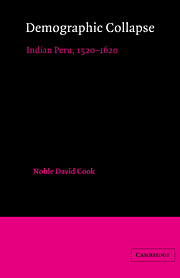Book contents
- Frontmatter
- Contents
- List of tables, figures, and maps
- Preface
- Introduction: The problem in perspective
- Part I Peru's preconquest population
- Part II Demographic collapse
- 8 First contact: north coast
- 9 Center of Spanish control: middle coast
- 10 Disease, earthquakes, and droughts: south coast
- 11 Intermediate area: northern highlands
- 12 Mining and population in the central sierra
- 13 The Indian heartland: southern highlands
- 14 An overview
- Abbreviations used in notes
- Notes
- Bibliography
- Index
- Titles in the series
9 - Center of Spanish control: middle coast
Published online by Cambridge University Press: 02 December 2009
- Frontmatter
- Contents
- List of tables, figures, and maps
- Preface
- Introduction: The problem in perspective
- Part I Peru's preconquest population
- Part II Demographic collapse
- 8 First contact: north coast
- 9 Center of Spanish control: middle coast
- 10 Disease, earthquakes, and droughts: south coast
- 11 Intermediate area: northern highlands
- 12 Mining and population in the central sierra
- 13 The Indian heartland: southern highlands
- 14 An overview
- Abbreviations used in notes
- Notes
- Bibliography
- Index
- Titles in the series
Summary
The hacienda system developed on the Peruvian coast in response to social and economic changes which took place during the century after the conquest. Of these changes, three were of primary importance: (1) the growth of the Spanish population, which was stimulated initially by the news of Cajamarca and later by the attractions of the coastal climate and new economic opportunities; (2) the rapid decline of the Indian population in the disastrous epidemics of the sixteenth century, and later as a result of the pressures generated by economic development; (3) the rise of agrarian markets to supply the needs of a sizeable Spanish urban population. Spanish population, which was stimulated initially by the news of Cajamarca and later by the attractions of the coastal climate and new economic opportunities; (2) the rapid decline of the Indian population in the disastrous epidemics of the sixteenth century, and later as a result of the pressures generated by economic development; (3) the rise of agrarian markets to supply the needs of a sizeable Spanish urban population.
Robert G. Keith, Conquest and Agrarian Change, p. 130The central Peruvian desert coast extends southward through several valley systems. The major rivers that descend to the Pacific and break the desert are the Pativilca, Huaura, Chancay, Rimac and Chillon, Malay, Caiiete, Chincha, Pisco, lea, and Nazca. At the time of the conquest, most residents of the central coast subsisted on the basis of irrigation agriculture, with food supplemented by marine resources. Most of the area was brought into the Inca Empire through conquests between 1460 and 1480. Pachacamac was the most important center in that sector of the Peruvian coastal region. It contained a relatively dense urban population and, as the chief ceremonial shrine along the entire coast, attracted a large number of temporary residents.
- Type
- Chapter
- Information
- Demographic CollapseIndian Peru, 1520–1620, pp. 145 - 164Publisher: Cambridge University PressPrint publication year: 1982



